Documents: Go to download!
User Manual
- User Manual - (English)
- User Guide - (French)
- Product spec sheet - (English)
- Installation Intructions - (English)
- SETTING OVEN CONTROLS
- CARE AND CLEANING
- BEFORE YOU CALL
Table of contents
User manual Wall Oven
SETTING OVEN CONTROLS
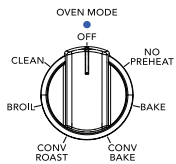
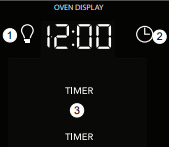
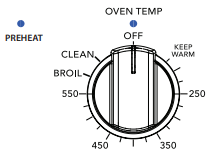
OVEN MODE SETTINGS
NO PREHEAT - Use no preheat for single rack items only and place food in center of oven before setting temperature.
BAKE - Use to select bake function before setting temperature.
CLEAN - Use to select clean feature cycle before setting clean with oven temperature selector.
CONV BAKE - Use to select convection baking before setting oven temperature.
CONV ROAST - Use to select convection roast for beef, lamb, pork, and poultry before setting oven temperature.
BROIL - Use to set broil feature before setting broil with oven temperature selector.
KEEP WARM - Set BAKE, CONV BAKE, or CONV ROAST mode, then set keep warm with oven temperature selector. Keep warm provides a low heat for keeping cooked foods at serving temperature.
OVEN DISPLAY FEATURES
1. Oven light - Use to turn on the internal oven light.
2. Clock - Use to set the time of day.
3. TIMER - Use to set or cancel the minute timer. The minute timer does not start or stop any cooking function.
OVEN TEMP SETTINGS - Use to set oven temperatures between 170°F (KEEP WARM) and 550°F. The CLEAN setting should only be used after reading all cautions and warnings in the “Self Cleaning” sections of this manual starting on page 22.

User Preference Settings
The default (factory) settings for sounds, energy saving, temperature offset, and convection convert are pre-set in the oven control. These may be changed by accessing the user preference display while the oven is in the idle mode and no timers are active.
Once the user preference menu is activated, the user can make changes and scroll through a menu of options, choosing from AUd (audible control setting), ES (energy saving), UPO (User Programmable Offset for changing the oven temperature), Aut (automatic convection convert), and dEF (default) setting with rSt reset choice (which will allow all preferences to reset to default settings).
Setting the Clock
The clock icon is used to access the time of day setting. When the oven is first plugged in or if there has been an interruption in power to the oven, 12:00 will flash in the display.
To set the correct time of day:
- Press the clock icon.
- The display will show a time along with a – and a + key in the display below.
- Press either – or + key to scroll to the correct time of day and release the key.
- The control will accept the new set time with a chime, and the control will show the time of day along with the two timers that are available.
NOTE The clock cannot be changed when the oven is set for cooking or self clean is active. Only a 12 hour clock is available on the Frigidaire Professional model.
Oven Light
The oven light will turn on automatically when the oven door is opened. The oven light may be turned on when the door is closed by using the oven light key located on the control panel.
Note: Keep oven light off while baking. The oven light will turn off during a clean cycle and not operate.
To toggle the oven lights on and off:
- Press oven light symbol
 .
.
The interior oven light is covered with a glass shield. The glass shield must be in place whenever the oven is in use.
To change the interior oven lights, see ““Replacing the Oven Light” in the Care & Cleaning section.
Setting the Timer
The minute timers in the oven display serve as extra timers to help keep track of cooking functions. The timer cannot be used during a self clean cycle or if the meat probe function associated with the timer display is in use. The minimum timer setting is 1 minute and the maximum setting is 11:59 (HR:MIN).
To set the timer:
- Press either TIMER key.
- The timer display will show 0:00 and the – and + keys on either side of the time display. NOTE: If the – key is pressed at this time an invalid key chime will sound.
- Press the + key to begin to scroll to the desired setting. If the + key is held, the timer value will increase rapidly. Once the desired setting is reached, release the key and the timer will start counting down automatically after a short time-out.
- The timer display will show the H:M icon if the timer is set for more than 1 minute. If the value is under 1 minute, the timer will display the time in seconds and the H:M icon will not appear.
- When the timer ends, a reminder chime will sound and repeat once every 60 seconds for a period of five minutes. Before the user can program an expired timer again, the timer key must be pressed.
- To cancel the timer before the set time expires, press the TIMER key.
NOTE The minute timers will not start or stop the cooking process. The minute timers can be used alone or while using most of the other oven features.
Setting Continuous Bake or 6 Hour Energy Saving
The oven is preset to cook up to 6 hours and to shut off automatically. For longer periods of cooking, this feature can be changed to continuous cooking by setting the user preference and turning the energy saving feature off.
To set the oven for continuous cooking:
1. Press and hold both the light icon and the clock icon at the same time for a few seconds until the display sounds an acceptance chime and the display will show one of the user preferences.
2. Press the + key in the upper part of the display until ES appears and ON is showing.
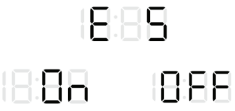
Figure 5: Energy saving with ON and OFF options
3. To turn the energy saving feature off, press the + or – key in the lower part of the display and OFF will appear in the display.
4. The control will accept the change in a few seconds and sound the acceptance chime. The oven is now set for continuous cooking.
5. To return to the time of day display, press and hold the light and clock icons at the same time for a few seconds until the display chimes and fades back to showing the time of day in the display.
Setting Control for Silent Operation
The oven is set to operate with certain chimes and tones (default settings) that alert the user to certain oven functions. The silent operation feature allows the oven control to be operated without sounds when necessary. By accessing user preferences, this option can be later returned to operate with normal programming sounds.
To set the oven control for silent operation:
1. Press and hold both the light icon and the clock icon at the same time for a few seconds until the display sounds an acceptance chime. AUd should appear in the display.
2. If Aud is not showing, press the + key in the upper part of the display until AUd appears and HI is showing in the lower part of the display. This is the normal (default) setting.

Figure 6: Default setting for oven control sounds
3. To turn the audible feature to a lower sound or completely OFF, press the + or – key in the lower part of the display until LO or OFF appears in the display

Figure 7:
4. When the desired setting appears in the display, release the key and wait for an acceptance chime.
5. To return to the time of day display, press and hold both the light and clock icons at the same time for a few seconds until the display chimes and fades back to showing the time of day
Setting No Preheat
Use the No Preheat feature when you want to start baking immediately, without the need for preheating. No Preheat provides good results when preparing convenience foods such as cinnamon rolls, frozen pizza, bacon, french fries, and tater tots. Food will finish cooking in the time stated in the package directions without the extra time required for preheating.
During No Preheat the convection fan will pulse on and off, and the bake element will cycle on and off to maintain the set temperature for precise baking.
Important: For batter and dough-based baked goods such as cakes, pastries, and breads, use the convection function for best results.
No Preheat is designed for baking on a single rack placed in the center of the oven and may be set for any temperature from 200°F to 550°F.
No Preheat tips for best results:
- Always place the food in the center of the oven on rack position 3 (Figure 8). No Preheat is designed for baking on a single oven rack.
- When using No Preheat, use bakeware with low or no sides. This allows the air to circulate around the food evenly.
- Food that comes in strips, such as fish sticks and chicken tenders, should be placed on the pan with the ends pointing to the sides of the oven.
- Follow the package directions for food preparation time and temperature. No Preheat works best when cooking foods longer than 10 minutes. If directions call for a shorter cooking time, a few extra minutes may be required for optimal cooking results.
- Do not open the oven door often. Opening the door will reduce the temperature in the oven and may increase bake time.
To set No Preheat:
1. Remove food from packaging and arrange on baking pan.
2. Place pan in oven on rack position 3 and close oven door.
3. Turn the oven mode selector to No Preheat.
4. Turn the oven temperature selector to the desired temperature. Baking will begin immediately.
5. To stop baking turn the oven mode selector and oven temperature selector to the OFF positions.
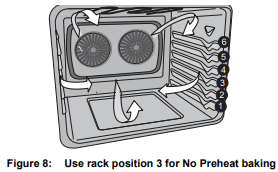
Setting Bake
Use the Bake function whenever a recipe calls for baking using normal temperatures. When the set bake temperature is reached the control will sound a chime to alert that the oven is fully preheated. During Bake, the convection fan may pulse on and off to help maintain optimum baking temperatures.
Important: For batter and dough-based baked goods such as cakes, pastries, and breads, use the convection function for best results.
Baking tips
For best bake results:
- Leave the oven light off while baking.
- Fully preheat the oven before baking items like cookies, cakes, biscuits, and breads.
- When using any single rack, position the rack so that the food is in the center of the oven.
- When using two oven racks, position cookware as shown in Figure 9. Allow at least 2-4 inches (5-10 cm) of space between cookware for proper air circulation.
- For best results when baking cakes using two oven racks, place Glide rack in position 4 with the flat rack in position 1. (See Figure 10).
- For cookies on multiple racks place sheets on rack position 3 using the flat rack, and 5 with the glide rack.
- Dark or dull bakeware absorbs more heat than shiny bakeware. It may be necessary to reduce oven temperature and cook time to prevent overbrowning of some foods. Dark bakeware is recommended for pies. Shiny bakeware is recommended for cakes, cookies, and muffins.
- Do not open the oven door often. Doing may increase the cooking time necessary for best results.
- Many factors can affect baking results. See “Solutions to Common Problems” on page 31 of this owner’s manual.
To set a bake for 350°F:
- Be sure to arrange racks to the desired positions.
- Turn the oven mode selector to the Bake position.
- Turn the oven temperature selector to 350°F.
- The PREHEAT and the oven temperature light will turn on and sound an acceptance tone. The oven will begin heating.
- When the set temperature is reached the PREHEAT light will turn off and a reminder chime will sound alerting you to place food in oven.
- Set either timer to keep track of actual cooking time if necessary.
- When finished baking, be sure to return both the temperature selector knob and the oven mode knob to the OFF positions.
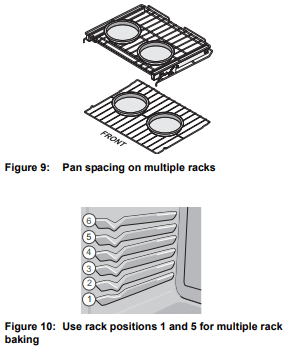
Setting Convection Convert
Convection convert automatically converts a standard baking recipe for convection baking. Convection convert may only be used with convection bake.This feature must be set before selecting the oven mode and oven temperature by using the user preference setting in the oven display.
Because convection baking generally cooks food faster than normal baking, food items should be checked for doneness before the suggested normal recipe cook times.
To set convection convert:
1. The oven temperature selector must be in the OFF position.
2. Turn the oven mode selector to CONV BAKE.
3. Press and hold both the oven light key and the clock key for about 3 seconds until Aut° (automatic convection convert) appears in the display.

Figure 13: Convection convert off (L) and on (R)
4. Press either the – or + key until On appears.
5. Turn the oven mode selector to the OFF position. The oven will accept the convection convert setting with an acceptance chime and the control will return to display the time of day. The convection bake function will now automatically convert normal baking temperatures for convection baking.
To change back to regular convection baking, repeat the same steps in this process and press the + or - key until OFF appears. Once the control accepts the change with a chime, turn the oven mode selector to OFF.
Setting Convection Roast
Convection roast is best for cooking tender cuts of beef, lamb, pork, and poultry. Use this mode when cooking speed is desired. Convection roasting gently browns the exterior and seals in the juices. Convection roasting uses the bake element, convection element, broil element, and fan to circulate the heat evenly and continuously within the oven.
Convection roasting tips:
- Use a broiler pan and grid, as well as a roasting rack (available by mail order). The broiler pan will catch grease drippings, and the grid will help prevent spatters. The roasting rack will hold the meat. Make sure the roasting rack is securely seated on the grid in the broiler pan. Do not use the broiler pan without the grid or cover the grid with aluminum foil.
- Pull the rack out to the stop position before removing food. Position food (fat side up) on the roasting rack.
- Do not open the oven door often. Doing so will reduce the temperature in the oven and may increase the cooking time necessary for best results.
- It is not recommended to roast chicken on a roasting rack. Use a deep pan and place on rack position 1 (offset rack).
To set oven for convection roasting:
1. Place meat on roasting rack and place in oven.
2. Turn oven mode selector to CONV ROAST.
3. Turn oven temperature selector to desired roasting temperature.
4. Once the control accepts the setting, the convection fan turns on and the oven will heat to the set temperature.
5. To cancel convection roast at any time, turn both the temperature control and the oven mode control to the OFF position.
Note: Preheating the oven for convection roasting is not necessary. At this time you may want to set TIMER as a reminder for checking food.
Using the Broil Feature
Use the broil feature to cook meats requiring direct exposure to radiant heat for optimum browning results. Broiling will produce some smoke. If smoke is excessive, place the food further away from the broil element. Always watch food carefully to prevent burning. Always arrange oven racks when the oven is cool. The door must be closed for broil to operate. If the door is left open the display will show "d-O". Close the door for the function to resume. When broiling, always pull the oven rack out to the stop position before turning or removing food.
To set broil:
1. Arrange oven racks while oven is cool. Turn the mode selector knob to BROIL. The indicator light will flash.
2. Turn the temperature selector knob to BROIL. The indicator light will turn on and remain lit. For optimum browning results, preheat oven for 2 minutes before adding food.
3. Place the broiler pan on the rack. Be sure to center the broiler pan directly under the broiler element.
4. Broil with the oven door closed. Always pull the oven rack out to the stop position before turning or removing food.
5. Turn the temperature and the selector knobs to OFF when broiling is complete or to cancel broil.

Adjusting the Oven Temperature
The temperature in the oven is pre-set at the factory. When first using the oven, be sure to follow recipe times and temperatures.
NOTE Do not use oven thermometers such as those found in grocery stores to check the temperature settings inside your oven. These oven thermometers may vary as much as 20 to 40 degrees from actual temperatures.
If you think the oven is cooking too hot or too cool for the temperature you select, you can adjust the actual oven temperature to be more or less than what is displayed by accessing the UPO (User Programmable Offset).
Before adjusting, test a recipe by using a temperature setting higher or lower than the recommended temperature. The baking results should help you to decide how much of an adjustment is needed.
Important: Before making a temperature adjustment, make sure both the oven mode and oven temperature control knobs are in the OFF position.
To adjust the oven temperature:
1. When the oven is idle, press and hold both the light icon and the clock icon at the same time for a few seconds until the display sounds an acceptance chime. AUd should appear in the display.
2. Press the + key in the upper part of the display until UPO appears and the default setting of 0° (or the last offset temperature) is showing.

Figure 20: UPO shown at default setting
3. Using the + or - key in the bottom of the display, press until the desired temperature change (offset) is reached. The display will change ± 5° with each key press to a maximum of + 35° or a minimum of – 35°F.

Figure 21: UPO shown 10° higher than default
If a lower temperature offset is desired, press the – key in the bottom of the display until the desired lower temperature appears.

Figure 22: UPO shown 10° lower than default
4. Release the key and the control will accept the change.
5. To return the display to normal, press and hold both the oven light icon and the clock icon at the same time until an acceptance chime sounds. The display will return to show the time of day.
NOTE Changing the UPO will not affect the broil or self clean temperatures.
Restoring Factory Control Settings
Your appliance was set with standard oven control settings. Over time these may have been changed. Restoring the control to factory (default) settings will affect the following:
- Continuous bake or 6 hour energy saving
- Silent or audible control
- Oven temperature adjustments
To restore oven control to default settings:
1. When the oven is idle, press and hold both the light icon and the clock icon at the same time for a few seconds until the display sounds an acceptance chime. AUd should appear in the display.
2. Press the + key in the upper part of the display until rSt appears and yes or no appears in the lower part of the display.

3. Press the + or - key to toggle between yes (to reset to default) or no (to leave current settings as they are).
4. When the desired setting appears, the control will accept the change after a few seconds with a beep and return to the clock mode.
Self Cleaning
A self cleaning oven cleans itself with temperatures well above normal cooking temperatures which eliminate soils completely or reduces them to a fine powdered ash you can wipe away with a damp cloth.
While the oven is in operation, the oven heats to temperature much higher than those used in normal cooking. Sounds of metal expansion and contraction are normal. Odor is also normal because the food soil is being removed. Smoke may appear through the oven vent.
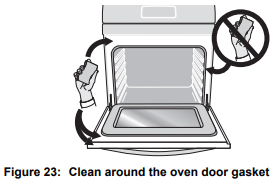
Setting Self Clean
If you are planning to use the oven directly after a self clean cycle, remember to allow time for the oven to cool down and the oven door to unlock. This normally takes about one hour. A 3 hour self clean cycle will actually take about 4 hours to complete.
It is recommended to use a 2 hour self clean cycle for light soils, a 3 hour cycle for average soils, and a 4 hour cycle for heavy soils.
To set the controls for a 3 hour self clean cycle and shut off automatically:
1. Turn both the oven mode and oven temperature selectors to CLEAN. The display will show a 3 hour time (normal clean) and the – and + keys.
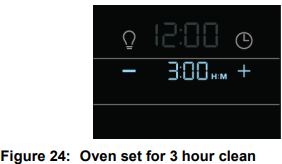
2. If a 3 hour clean is desired, the control will accept the time within 3 seconds. However, the user may select a 2 or 4 hour clean by using the – or + keys to change to the desired clean time and then allow the control to accept the change.
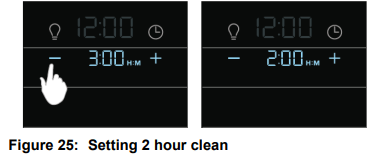
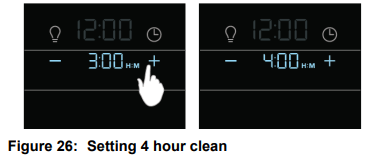
Once the control accepts the clean time the display will flash a reminder for the user to REMOVE RACKS. The
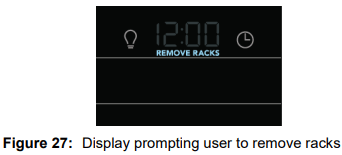
REMOVE RACKS notification will flash for a few seconds prompting the user to remove all oven racks. If the oven door is opened as this time the display will show CLO to indicate that the door must be closed before the clean cycle can begin. If the door remains open for more than 3 minutes, the clean function will be canceled.
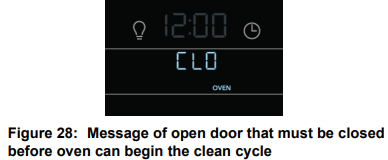
When the oven is set to run the clean cycle, the motor door lock will begin locking the oven door. Do not open the oven door while the lock motor is running or when any locking indicators or displays are showing. The oven door is completely locked in about 15 seconds.
3. Once the door is closed the time of day will be visible along with the selected clean time and the door lock icon will be blinking in the display. Do not force the oven door open when the self clean is active. This can damage the automatic door locking system.
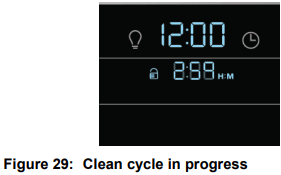
4. During the clean cycle the time of day remains in the display and the time remaining in the clean cycle will also be active.(Figure 29)
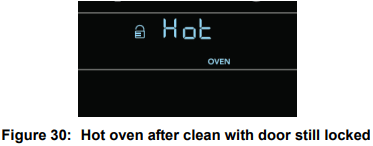
5. When the clean cycle ends the oven will be too hot for the door to unlock until the oven cools to a safe temperature. This may take up to an hour. During this time the display will show Hot along with the door lock icon.
6. Once the oven temperature reaches a safe level, CLn will appear in the display and the lock icon will blink to signal the end of the clean cycle with a chime. Do not force the oven door open when the lock icon is showing in the display; this can damage the automatic door locking system.
7. Move both the oven mode and temperature mode knob to the OFF position to clear the display.
Caution: To avoid possible burns, use care when opening the oven door after a self clean cycle. Stand to the side to allow any steam and heat to escape. The internal oven temperature will still be hot enough to cause burns even though the bake and broil elements appear to have cooled.
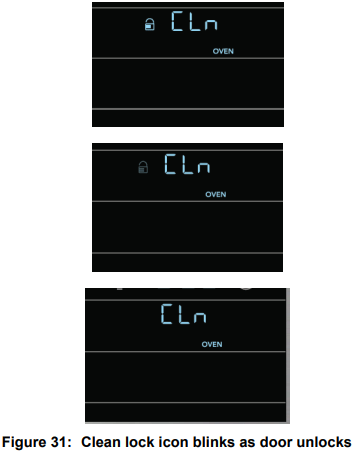
Note: Once the clean cycle ends the oven will not be available for another clean for 4 hours.
To cancel a self clean before it ends:
Turn both the oven selector knob and the oven temperature knob to the OFF position.
CARE AND CLEANING
General Cleaning
Refer to the table at the beginning of this chapter for more information about cleaning specific parts of the oven.
Follow these cleaning precautions:
- Allow the oven to cool before cleaning.
- Wear rubber gloves when cleaning the appliance manually.
Remove soils using hot, soapy water. Do not allow food spills with a high sugar or acid content (such as milk, tomatoes, sauerkraut, fruit juices or pie filling) to remain on the surface as they may cause a dull spot even after cleaning. Remove spillovers and heavy soiling as soon as possible. Regular cleaning will reduce the effort required for major cleaning later.
Cleaning Porcelain Enamel Oven
The oven interior is porcelain on steel, it is safe to clean using oven cleaners.
To remove heavy soil:
1. Allow a dish of ammonia to sit in the oven overnight or for several hours with the oven door closed. Clean softened dirt spots using hot, soapy water. Rinse well with water and a clean cloth.
2. If soil remains, use a nonabrasive scouring pad or a nonabrasive cleaner. If necessary, use an oven cleaner following manufacturer's instructions. Do not mix ammonia with other cleaners.
3. Clean any soil from the oven frame, the door liner outside the oven door gasket and the small area at the front center of the oven bottom. Clean with hot, soapy water. Rinse well using clean water and a cloth.
Boiler Pan Cleaning Tips
To prevent grease from baking on, remove the broiler pan from the oven as soon as cooking is completed. Use oven mitts because the broiler pan is extremely hot. Pour off grease. Soak the pan in hot, soapy water.
Clean the broiler pan as soon as possible after each use. If necessary, use soap-filled steel wool pads. Heavy scouring may scratch the grid.
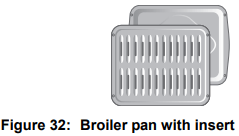
Aluminum Foil, Aluminum Utensils, and Oven Liners
Protective liners—Do not use aluminum foil to line the oven bottom. The high heat of the oven can melt these materials to the oven cavity and ruin the oven. These types of materials can also reduce the effectiveness of the air circulation in the oven and produce poor baking results. Only use aluminum foil as recommended in this manual. Improper installation of these liners may result in risk of electric shock or fire.
Aluminum utensils - The melting point of aluminum is much lower than that of other metals. Care must be taken when aluminum pots or pans are used.
Oven racks - Do not use aluminum foil to cover the oven racks. Using a liner in the oven restricts the heat and air flow needed to obtain the best possible cooking results for any oven.
Adhere to the following precautions when using spray oven cleaners:
Do not spray cleaner on the electrical controls or switches because it could cause a short circuit and result in sparking or fire.
Do not spray any cleaner on the oven door trim or gasket, broiler drawer glides, handles or any exterior surfaces of the oven, plastic or painted surfaces. The cleaner can damage these surfaces.
Do not allow a film from the cleaner to build up on the temperature sensing bulb; it could cause the oven to heat improperly. The bulb is located in the rear of the oven. Carefully wipe the bulb clean after each oven cleaning, being careful not to move the bulb. A change in its position could affect how the oven bakes. Avoid bending the bulb and capillary tube.
Replacing the Oven Light
The interior oven lights are located at the rear of the oven cavity and is covered by a glass shield. The glass shield must be in place whenever the oven is in use (Figure 33).
To replace the oven interior light bulb:
- Turn electrical power off at the main source or unplug the appliance.
- Remove interior oven light shield by turning a quarter turn counter-clockwise.
- Replace bulb with a new T-4 type Halogen 25 watt appliance bulb.
- Replace glass oven light shield by rotating clockwise.
- Turn power back on again at the main source (or plug the appliance back in).
- Be sure to reset the time of day on the clock

Caring for your glide racks
Important: Remove all oven racks before starting a self clean cycle. If oven racks are left inside the oven during a cleaning cycle, the slide ability of the glide rack may be damaged and the racks will lose their finish.
- Anytime the gliding is rough, the glide rack tracks should be treated with graphite lubrication.
- Do not use cooking oil, cooking spray, or other oil-based lubrication products on the glide rack extension tracks. Use only the graphite lubrication in this area. To order graphite lubrication, contact your installer, servicer or dealer.
To lubricate the glide rack:
1. Remove the rack from the oven and place the rack on a large flat surface covered with newspaper or scrap cloth. Fully extend the rack.
2. Wipe away debris and crumbs from the glide track using a cloth or sponge.
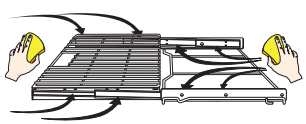
3. Shake graphite lubrication very well before applying. Place four drops of graphite lubrication along the tracks (see area circled on figure below). Repeat on both sides of the glide rack.
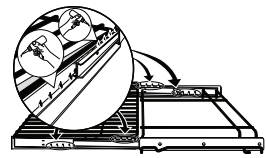
4. Extend and return the glide rack several times along the tracks to distribute the lubrication.

5. Turn glide rack over. Shake graphite lubrication very well before applying. Place four drops of graphite lubrication along the tracks. Repeat on both sides of the glide rack.
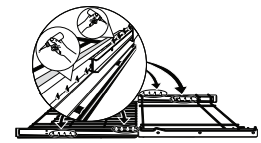
6. Extend and return the glide rack several times along the tracks to distribute the lubrication.

7. Apply a thin layer of cooking oil to the outer frame of the glide rack as shown below. Keeping the frame sides lightly lubricated allows the entire rack to slide easily when changing rack positions.
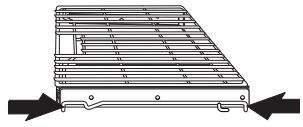
8. Replace rack in oven right side up.
BEFORE YOU CALL
Solutions to Common Baking Problems
For best cooking results, fully preheat the oven before baking cookies, breads, cakes, pies or pastries, etc.
There is no need to preheat the oven for roasting meat or baking casseroles.
The cooking times and temperatures needed to bake a product may vary slightly from your previously owned appliance.
Baking Problems and Solutions Chart
| Baking Problems | Causes | Corrections |
|
Cookies and biscuits burn on the bottom.
|
• Cookies and biscuits put into oven before the preheating time is completed. • Oven rack is overcrowded. • Dark pans absorb heat too fast. |
• Allow oven to preheat to desired temperature before placing food in oven. • Choose pan sizes that will permit 2 to 4 inches (5.1 to 10.2 cm) space on all sides when placed in the oven. • Use a medium weight baking sheet. |
|
Cakes too dark on top or bottom.
|
• Cakes put in oven before preheating time is completed. • Rack position too high or too low. • Oven too hot. |
• Allow oven to preheat to the selected temperature before placing food in the oven. • Use proper rack position for baking needs. • Set oven temperature 25°F (13°C) lower than recommended. |
|
Cakes not done in center.
|
• Oven too hot. • Incorrect pan size. • Pan not centered in oven. |
• Set oven temperature 25°F (13°C) lower than recommended. • Use pan size suggested in recipe. • Use proper rack position and place pan to allow for 2 to 4 inches (5.1 cm to 10.2 cm) space on all sides of pan. |
|
Cakes not level.
|
• Oven not level. • Pan too close to oven wall or rack overcrowded. • Pan warped. • Oven light left on while baking. |
• Place a marked glass measuring cup filled with water on the center of the oven rack. If the water level is uneven, refer to the installation instructions for leveling the oven. • Be sure to allow 2” to 4” (5.1 cm to 10.2 cm) of clearance on all sides of each pan in the oven. • Do not use pans that are dented or warped. • Leave oven light off while baking. |
|
Foods not done when cooking time is over.
|
• Oven too cool. • Oven overcrowded. • Oven door opened too frequently. |
• Set oven temperature 25°F (13°C) higher than suggested and bake for the recommended time. • Be sure to remove all pans from the oven except the ones to be used for baking. • Open oven door only after shortest recommended baking time. |
Solutions to Common Problems
Before you call for service, review the following list. It may save you time and expense.
Possible solutions are provided with the problem listed:
| Problem | Solution |
| Oven control panel beeps and displays error codes |
• Oven control has detected a fault or error condition. When this occurs an E or F will show in the display. • Turn both oven selectors to the OFF position; Activate a Bake or Broil using both the oven mode and temperature selectors. • If the F or E code error repeats, turn off power to appliance, wait 5 minutes and then repower appliance. Set clock with correct time of day. • Try Bake or Broil function again. If a fault code appear again, turn both oven selectors to the OFF position to clear the error code and contact your servicer. |
| Poor baking results |
Many factors effect baking results. • Use proper oven rack position. • Center food in the oven and space pans to allow air to circulate. • Preheat oven to the set temperature before placing food in the oven. • Try adjusting the recipe's recommended temperature or baking time. See “Adjusting the Oven Temperature”on page 21 if you feel the oven is too hot or cold. |
| No Preheat performs poorly | • No Preheat not used correctly. This cooking function is intended for convenience, precooked, and other specific foods. See “Setting No Preheat” on page 12 and follow tips for best using this feature. |
| Appliance is not level |
• Poor installation. Place oven rack in center of oven. Place a level on the oven rack to check if oven has been properly installed. • Kitchen cabinet alignment may make oven appear not level. Be sure cabinets are square and have sufficient room for appliance clearance. • If cabinets are not square or are built in too tightly, contact builder or installer to make appliance accessible. |
|
Cannot move appliance easily Appliance must be accessible for service |
• Cabinets not square or are built in too tightly. • Contact builder or installer to make appliance accessible. |
| Appliance does not operate |
• Electrical power outage. Check house lights to be sure. • Call your local electric company for service outage information. • Service wiring is incomplete. Call 1-800-944-9044 for assistance. |
| Flames inside oven or smoking from oven vent |
• Excessive spills in oven. Grease or food spilled onto oven bottom or oven cavity. Wipe up excessive spills before starting oven. • If flames or excessive smoke are present when broiling, see “Using the Broil Feature” on page 17. |
| Oven does not operate. |
• The time of day is not set. The oven clock must first be set in order to operate the oven. See “Setting the Clock”on page 10. • Be sure oven controls are set properly. See “OVEN DISPLAY FEATURES” beginning on page 9 and review instructions for the desired cooking function in this manual. |
| Oven smokes excessively when broiling. |
• Incorrect setting. See “Using the Broil Feature” on page 17. • Meat too close to the broil element. Reposition rack to provide proper clearance between the meat and broil element. Remove excess fat from meat. Cut remaining fatty edges to prevent curling, but do not cut into lean. • Grease build up on oven surfaces. Regular cleaning is necessary when broiling frequently. Grease or food splatters will cause excessive smoking. |
|
Oven racks discolored or do not slide easily. Glide racks |
• Clean by using a mild abrasive cleaner following manufacturer's instructions. Rinse with clean water, dry, and replace in oven. • To maintain glide rack see “Caring for your glide racks” on page 29. |
| Oven light does not work. | • Be sure the oven light is secure in the socket. “See “Replacing the Oven Light”on page 27. |
| Fan noise occurring after the oven is turned off | • Some models are equipped with a cooling fan that runs during the cooking process to cool internal electronic components. It is normal for this fan to continue to run for an extended period of time, even when the oven has been turned off. |
See other models: FPET3077RF FFCE1439LB FGTR1837TE FGMO205KF FPMO3077TF






